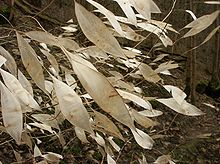Silver leaves
| Silver leaves | ||||||||||||
|---|---|---|---|---|---|---|---|---|---|---|---|---|

Annual silver leaf ( Lunaria annua ) |
||||||||||||
| Systematics | ||||||||||||
|
||||||||||||
| Scientific name | ||||||||||||
| Lunaria | ||||||||||||
| L. |
The plant genus Lunaria belongs to the cruciferous family (Brassicaceae). The species of this genus have many German-language trivial names : the most common is the silver leaf , but often silver thaler , silver coin , Judas penny or moon vole are also used. The Lunaria species are native to many gardens as ornamental plants .
description


Vegetative characteristics
The Lunaria species grow as annual, biennial or herbaceous plants . The more or less hairy stems are erect and branched.
The opposite or alternately arranged leaves are usually divided into a petiole and a leaf blade. The simple leaf blade is ovoid to heart-shaped with a serrated leaf margin.
Generative characteristics
The flowers stand together without bracts in short racemose inflorescences . The stalked flowers are hermaphroditic and four-fold. The four sepals are upright. The four nailed petals are purple or white. The petals are about twice as long as the sepals. The six stamens have long anthers . The short style ends in a two-lobed scar.
The large pods contain a few large, winged seeds.
Systematics
The genus Lunaria was established by Carl von Linné . The generic name Lunaria , derived from Latin, means "moon plant" and refers to the sometimes circular, silvery shimmering partitions ("false partitions" in the frame of the Repla) of the pods that are left over in autumn and are reminiscent of the moon. The genus Lunaria is not assigned to any tribe.
There are about three types:
-
Annual silver leaf ( Lunaria annua
L .: It originally comes from Southeastern Europe , has been widely planted and has grown wild in numerous countries. There are two subspecies:
- Lunaria annua L. subsp. annua (Syn .: Lunaria biennis Moench ))
- Lunaria annua subsp. pachyrrhiza (Borbás) Hayek
- Perennial silver leaf ( Lunaria rediviva L. , Syn .: Lunaria alpina Bergeret ): It is widespread in Europe.
- Lunaria telekiana Jáv. : This endemic occurs only in northern Albania . This species is also persistent like Lunaria rediviva , but the pod has only a carpophore of about 1 millimeter in length in contrast to that of Lunaria rediviva with 25 to 40 millimeters in length.
use
All three species are used as ornamental plants because of their large, colored flowers and the later silvery shimmering ripe pods. The dried stems have also been used for decorative purposes since the 18th century.
The Lunaria species thrive best in warm, sunny or partially shaded locations and on nutrient-rich soils . Lunaria species can be propagated by sowing or vegetatively by division .
swell
- SMH Jafri: Brassicaceae in the Flora of Pakistan : Lunaria - online with the same text as the printed work.
- Peter William Ball: Lunaria L. on p. 358. In: Thomas Gaskell Tutin et al .: Flora Europaea. 2nd edition, Volume 1, Cambridge University Press 1993, ISBN 0-521-41007-X .
